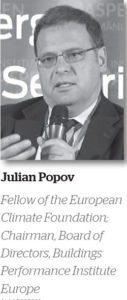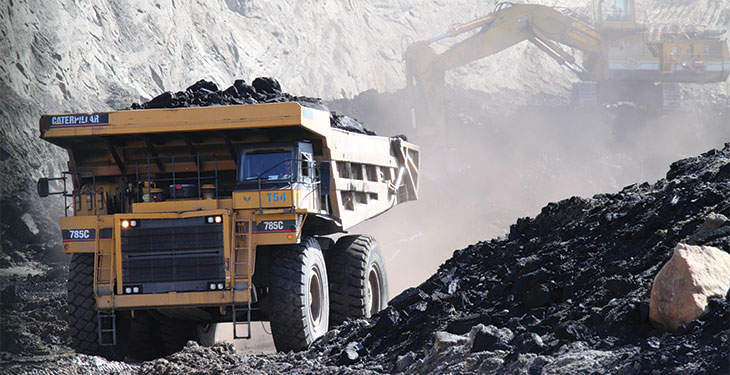We challenged Mr. Julian Popov to comment the current situation for the coal-based power generation sectors in Romania and Bulgaria; what we got was a spectacular overview of the energy landscape in the region, and in Europe. Mr. Popov displayed a complex, but clean-cut description, where renewables are ready to jump in to save the coal regions from nothingness, natural gas has a good future, but a rather short one, large national projects should be replaced by market integration, and all strategies ought to begin from energy efficiency for reduced energy poverty, improved air quality and increased energy security.
This year, every corner of the energy industry nested at least one hot topic: offshore E&P, renewable sector, energy efficiency to name only a few. Coal based power generation is one of these hot topics in Romania, as well as in Bulgaria. Why do you think this sector rose on the top of the agenda in 2018?

Analyzing the national power generation mix, economies and societies in both of our countries, coal reveals itself as an important element, difficult to discard on short term. What do you believe to be the best approach at the moment in respect to the coal based power generation units?
Indeed. Around 40% of the power generation in Bulgaria and more than 20% in Romania depend on coal. We have to face the growing cost of coal and understand and use the energy transformation. If we do that, we will not only succeed in reducing any negative effects from energy mix transformation, but turn the transition into an advantage for our countries. We need to run ahead of the energy economics curve. We should start developing national strategies for exploiting our cost competitive clean energy resources and start introducing technologies for managing the energy supply and demand.
I know that there are discussions in Brussels on modifying the ETS mechanisms, on one hand, and on introducing some kind of capacity mechanisms, on the other hand, for awarding the balancing role of the coal-based power generation units. What are the possible solutions available to maintain this activity economically feasible?
ETS is constantly developing, but I don’t think there is a chance for coal to be awarded a balancing role. Some countries with high share of coal in the energy mix are looking for ways to prevent shock to the energy system and mainly to avoid politically difficult clash with coal regions and trade unions, but that will not happen through bending the logic of the ETS. The economically feasible way is to analyze where the lowest cost low carbon potential is and to start positioning our countries to better use the low carbon power generation. It is also very important for Bulgaria and Romania to work together on the energy transition because the transition is intrinsically linked to the electricity market integration. We have to plan together new power capacity, market rules and infrastructure. We also have to work jointly on demand forecasts. If we build excessive inadequate and expensive power capacity, we will face serious problems in the future. Our nuclear plans need to be re-evaluated in this context. We also have to move away from reliance on subsidies and contracts with fixed guaranteed long term prices towards more flexible market mechanisms based on auctions, demand management and encouragement of innovation.
The trouble of some might be the bless for others… Do you believe that gas powered power plants, or renewables might be the proper replacements for these capacities? How soon might this happen?
We should start the capacity conversations with the question “What consumption can we avoid?”. Both Bulgaria and Romania have huge potential in improving the energy efficiency of their economies. Efficiency is not only helping to reduce consumption, but it also helps to reduce energy poverty, improve air quality, increase energy security; it is also a way to increase the choice of energy technologies. A low efficiency building requires energy intensive heating, while a well-insulated building has much wider choice of cost competitive heating technologies. Once we examine the energy efficiency options we can move towards generation options. Gas can certainly play a role, but the idea for gas as a transitional fuel is exaggerated and misunderstood. Gas could play a role in the transition mainly if it replaces coal rapidly and works in conjunction with renewables, storage and demand management. South East Europe has huge cost competitive renewables potential that is cheaper than anything else, except energy efficiency gains. We also have a significant hydro energy potential which offers excellent balancing and storage opportunity for the regional energy system.
Are there any successful examples of energy transition from coal to any other less impactful technologies that countries like Romania and Bulgaria might contemplate? What is your take on the situations in Poland and Germany?
There are many cases of regions moving away from coal driven by different factors – new fuels, air quality or climate related policies. In the 1960s, when gas from the North Sea became available the Netherlands and England started their transitions in two very different ways. England’s story is much more confrontational, the Dutch one is much more amicable, consultational and consensual. Both countries moved away from coal and soon they will stop using coal completely.
The German Ruhr valley is also an interesting example of moving away from coal and developing advanced technology industries. The transition of the Northern France region of Loos-en-Gohelle which became a UNESCO heritage site is an interesting case. There are stories in Poland and Hungary and many examples in the US. In the ‘60s, Hungary was employing 125,000 miners, it employs 2,000 now. All these cases are specific and different, but the general lesson from all of them is that technology change is an opportunity which needs to be understood, supported and managed wisely in favor of new development, cleaner solutions, higher efficiency and modernization of the energy sector and the industry as a whole. Opposing this trend and opportunity can send us at the bottom of the industrial development, while embracing it could catapult us near the top.
—————————————-
This interview firstly appeared in the printed edition of energynomics.ro Magazine, issued in December 2018.
In order to receive this issue of energynomics.ro Magazine, we encourage you to write us at office [at] energynomics.ro to include you in our distribution list. All previous editions are available HERE.

